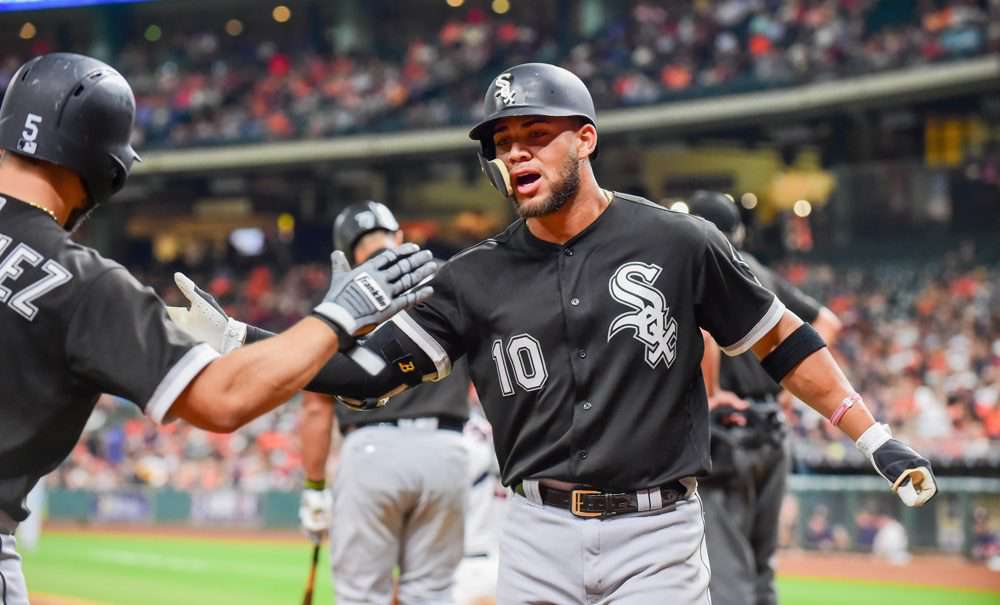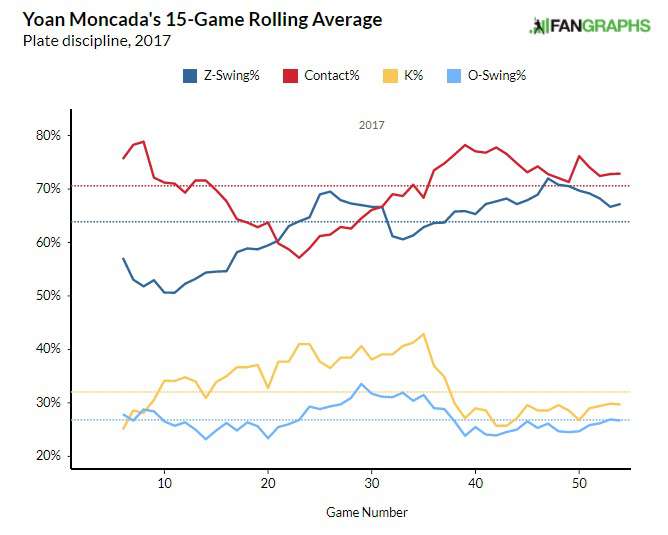
Few prospects ever receive as much fanfare as Yoan Moncada did. It was fair to give him so much attention, however, considering the price Boston paid to land the young Cuban — a cool $63 million. His signing bonus from the Red Sox was $31.5 million, and they paid 100% tax on that since they exceeded their bonus pool money. Well worth it in their estimation, given his pedigree as one of the best young players in the world.
He did nothing to quell those notions throughout his first two seasons in the minors. He stole 49 bases in 2015 with a .378 wOBA in Single-A Greenville. He followed that up with another 36 steals and a .417 wOBA in Advanced-A Salem before a promotion to Double-A Portland, where he continued to mash over 45 games, stealing another nine bags and posting a .404 wOBA. He earned a September call-up with those numbers, but the young phenom was overmatched in the majors, striking out 12 times over 20 plate appearances.
That would be the only time he donned a Boston uniform. He was shipped off to Chicago as the headliner of the deal that sent Chris Sale to the Red Sox, thus switching the color of his Sox from Red to White (we’ll set aside the fact that the White Sox’s socks are actually black). He then played 80 games at Triple-A Charlotte, posting a .367 wOBA as 21-year-oldld, which is still very impressive. His stolen bases fell to 17, though, which is understandable given the more advanced pitching in the upper levels of the minors. He was also caught eight times, giving him a 68% success rate, which is below where you’d like to see it.
Enter his first real taste of the majors. He debuted with the White Sox on July 19, going 0-for-3 with a walk. He would see 231 plate appearances with the Sox over the second half of the season, hitting .231/.338/.412 with eight homers and just three steals. The batting average is troubling considering he still managed a .325 BABIP, but he struck out an unacceptable 32% clip. So is this the type of production we should expect from him in 2018, or are we looking at a potential breakout?
We’ll start with what should, at the very least, keep his value afloat — his speed. As I stated, Moncada stole 20 bases in 2017 between Triple-A and the majors. There were only 17 players in baseball that stole 20+ bases last year, making his stolen base floor very valuable in this steal-starved climate (check out Van Lee’s piece about stolen bases here for more on this). It gives me some pause that he attempted only five steals in 54 games with Chicago, but I expect him to get more aggressive on the bases as he gets more comfortable in the bigs. I would consider 15 steals as his floor over a healthy season, which is still a feat only 34 players managed to do in 2017. Fifteen steals doesn’t really sound like much, but unless he completely tanks in every other aspect of his game, that’s a player you’re hanging onto all season.
Next, we need to address that strikeout rate. It’s bad. Moncada struck out a lot throughout his minor league career, as well, so it’s not like this issue appeared out of nowhere. However, MLB pitching is a different beast, and he had a 32% K% with 71% contact and a 12.6% swinging strike rate. Those numbers don’t look great on the whole, but if we look into his splits per month, we find promise. Here’s a handy dandy chart to put things into perspective.

After doing his best to tread water throughout July and August, something seemed to click in September. Moncada’s strikeout rate in 24 September games dropped to 27.5%. He got more aggressive on pitches in the zone and made more contact overall. He did all of this while swinging at fewer pitches outside of the zone, leading to a .351 wOBA. He served as the White Sox’s No. 2 hitter the entirety of the month, as well, so it’s not like they were hiding him in the eight hole. Moncada should hit first or second throughout 2018, putting him in a great spot for R+RBI production despite being part of an admittedly less-than-intimidating Pale Hose lineup.
The final part of Moncada’s profile we have yet to touch on is his power. He hit 20 home runs over 134 games between Triple-A and the majors, giving him a 20/20 season with both levels combined. In Chicago, he put a solid 35% of balls into the air and maintained an above-average 36% hard contact rate. That yielded an 18.2% HR/FB rate, a number that doesn’t seem too far above his head considering his hitter-friendly home park. He’s never been one to get pull-happy for power (42% pull% in 2017), so I wouldn’t expect a higher ISO than the .181 he posted with Chicago. However, given the power increase we’ve seen across the board, I wouldn’t project a ton of regression, either. A .181 ISO over the course of 145 games would look something like 25 home runs.
Do I really think Yoan Moncada is going to go 20/20 in 2018? Well, yes. Yes, I do. Is it a bit optimistic? Perhaps, but it’s a very real possibility. He’s going to need to make contact and keep the strikeout rate in the area of 27% like he did in September to accomplish that. Also, one month of data is far too small a sample size to feel comfortable drawing conclusions from. That said, he is an incredible talent, and it seemed he was adjusting to MLB pitching by the end of the 2017 season. Heck, there’s also the upside outcome where he fully breaks out and goes closer to 25/25 with a batting average that doesn’t make you grind your teeth whenever you look at it. He is currently the 10th second baseman being drafted, 115 overall according to Fantrax ADP. At that price point, the upside outweighs the risky floor, and I’m set to invest.
Course Correction Series
